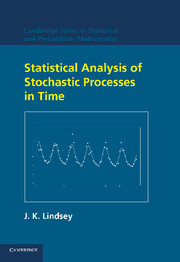Book contents
4 - Recurrent events
Published online by Cambridge University Press: 03 February 2010
Summary
We now are ready to examine processes in which more than one event can occur. For the moment, only a small number of possible outcomes or states will be allowed. Indeed, in this chapter, I shall concentrate on the simplest case, with only two states. One of the states will dominate, with the other occurring only occasionally. The latter will be a point event, occuring from time to time and yielding a recurrent event process (Section 1.1.2). After survival processes, this is one of the simplest types of stochastic process. I shall leave the more complex case of several types of events to the following chapters.
In contrast to survival processes, here the event will not involve entry to an absorbing state. Indeed, the second state will be so transitory (at a point in time) that the event does not really signal a change of state at all. Thus, a binary indicator can be used, such that, at any time point, it will be 1 if the event occurs and 0 otherwise. Hence, this can also be called a binary point process. Generally, only the times of events, called the arrival times, or the times between events, called the interarrival times, are recorded, the latter being similar to survival data.
In the simplest cases, the varying interarrival times between recurrent events can be assumed to be independent and identically distributed. In such a situation, we shall have a renewal process (Section 4.1.4). This term comes from industry where certain machines or parts must be replaced or renewed at varying intervals of time. However, models for renewal processes have much wider application.
- Type
- Chapter
- Information
- Statistical Analysis of Stochastic Processes in Time , pp. 71 - 100Publisher: Cambridge University PressPrint publication year: 2004

